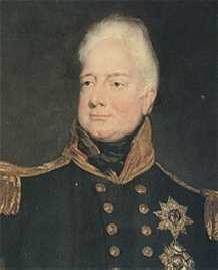

William
IV 1830-1837|
Born: Buckingham Palace, London. 21st August 1765. |
|
Titles: William Henry, King of the United Kingdom of Great Britain and Ireland; Duke of Clarence. |
|
Crowned: Westminster Abbey, 8th September 1831. |
|
Ruled: 26 June 1830-20 June 1837. |
|
Married: 13 July 1818, at Kew Palace, Adelaide Louise Theresa Caroline Amelia (1792-1849), dau. George, Duke of Saxe-Meiningen: 6 children (4 stillborn). William also had at least eleven illegitimate children, ten by Dorothea Bland (1761- 1816). |
|
Died: Windsor Castle. 20th June 1837. Aged 71. |
|
Buried: St George's Chapel Windsor |
W
illiam was the third son of George III and had not expected to become king. It was the death of George IV's daughter Charlotte in 1817, followed by the death of George's brother, Frederick (the "Grand Old Duke of York" of the nursery rhyme), in 1827 that made William the heir presumptive. Until then he had led a life fairly distanced from the extravagant carousel of his brother. William entered the Navy in 1779 at the age of fourteen and served at the relief of Gibraltar. He received few concessions initially because of his status, but served first as an able seaman, rising to midshipman and then rising through the ranks. He served under Nelson during 1786/7 in the West Indies, and was given the command of his own frigate, the Andromeda, in 1788 and the next year was appointed the Rear Admiral of HMS Valiant. He was made duke of Clarence in 1789 and thereafter regularly attended the House of Lords. He was made Admiral of the Fleet in 1811 and delighted in the official duties that imposed.Like his brothers, William was an inveterate womaniser. During a visit to Hanover in 1784 he was supposed to have seduced and even entered into a secret marriage with Caroline von Linsingen. The marriage was unlikely (though it seemed to be a tradition amongst the Hanoverians) but the seduction was very likely and she bore him a son called William, who drowned in 1807. A typical sailor, Prince William had a girl in every port, but in 1790 William fell in love with the actress Dorothea Bland, better known by her stage name Dorothea Jordan. Although they did not marry, they lived happily together for twenty years. She bore him ten children who adopted the surname Fitzclarence. Their descendants live to this day. William suddenly abandoned Dorothea in 181 1, probably because she had become an alcoholic and was no longer attractive. She tried to return to the stage, without success, and died following a mental collapse in France in 1816. William's callous treatment of her was out of character with his past actions, but probably a true representation of the real man.
William did not marry until after the death of his brother's heiress, the Princess Charlotte. He was fifty-two when he married the twenty-five-year-old Princess Adelaide, but despite the age difference the two became devoted to each other and she became a devoted stepmother to William's illegitimate flock. Unfortunately none of their children survived infancy.
William was nearly sixty-five by the time he became king and by then he had become a bad-tempered, miserly old man who delighted in being obstinate. He refused to have an extravagant coronation like his brother's, but insisted that it be simple, and he thereby abandoned much of the tradition that had accompanied the ceremony. He felt rather that he was a caretaker monarch, holding the throne for his niece Victoria and determined to survive long enough to avoid her mother, the duchess of Kent, becoming regent. He had no interests in art, science or literature, though he did establish a Royal Library at Windsor because it seemed strange without one.
His single most significant contribution to the advance of the nation came in 1832 when, against his own personal judgement, he supported Earl Grey and encouraged the Tory peers to abstain from voting against the Reform Bill, securing its passage. This was the start of modern democracy in Britain, reforming the representation of the people. This opened up the opportunity for a series of reforms, most of which would come to fruition in Victoria's reign. Others of importance were passed in 1833 - the Factory Act, against child labour, and the Abolition Act, which emancipated slaves in the British colonies. The Poor Law of 1834 was a well-intentioned piece of legislation, institutionalising the workhouse. Much of the administration of Britain was still at the level where it could transport the Tolpuddle Martyrs to Australia in 1834 for calling a trade union meeting of agricultural workers. Public reaction to their sentence added fuel to the growing Chartist movement for political and social reform. William found all of this reform rather distressing, as if the whole moral structure of the nation was collapsing. He died of pneumonia and cirrhosis of the liver on 20 June 1837, the last of the Hanoverian kings. Little did he realise that his successor, Victoria, would rule for the rest of the century and rule over the greatest empire the world had seen.
By kind permission of "The Kings and Queens of England Website" (http://www.frhes.freeserve.co.uk/)